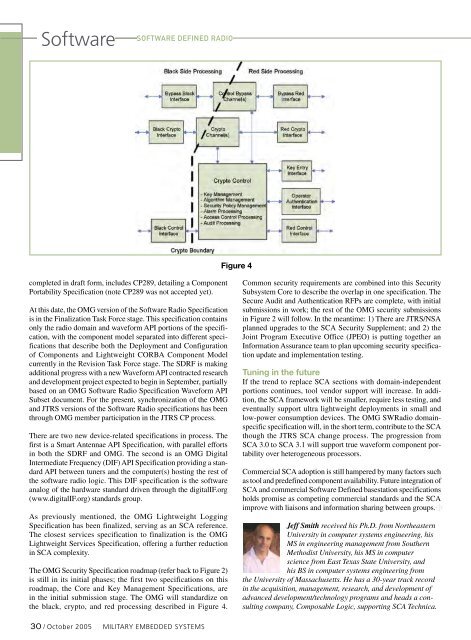Military Embedded Systems - Fall 2005 - Volume 1 Number 2
Military Embedded Systems - Fall 2005 - Volume 1 Number 2
Military Embedded Systems - Fall 2005 - Volume 1 Number 2
Create successful ePaper yourself
Turn your PDF publications into a flip-book with our unique Google optimized e-Paper software.
Software<br />
Software Defined Radio<br />
Figure 4<br />
completed in draft form, includes CP289, detailing a Component<br />
Portability Specification (note CP289 was not accepted yet).<br />
At this date, the OMG version of the Software Radio Specification<br />
is in the Finalization Task Force stage. This specification contains<br />
only the radio domain and waveform API portions of the specification,<br />
with the component model separated into different specifications<br />
that describe both the Deployment and Configuration<br />
of Components and Lightweight CORBA Component Model<br />
currently in the Revision Task Force stage. The SDRF is making<br />
additional progress with a new Waveform API contracted research<br />
and development project expected to begin in September, partially<br />
based on an OMG Software Radio Specification Waveform API<br />
Subset document. For the present, synchronization of the OMG<br />
and JTRS versions of the Software Radio specifications has been<br />
through OMG member participation in the JTRS CP process.<br />
There are two new device-related specifications in process. The<br />
first is a Smart Antennae API Specification, with parallel efforts<br />
in both the SDRF and OMG. The second is an OMG Digital<br />
Intermediate Frequency (DIF) API Specification providing a standard<br />
API between tuners and the computer(s) hosting the rest of<br />
the software radio logic. This DIF specification is the software<br />
analog of the hardware standard driven through the digitalIF.org<br />
(www.digitalIF.org) standards group.<br />
As previously mentioned, the OMG Lightweight Logging<br />
Specification has been finalized, serving as an SCA reference.<br />
The closest services specification to finalization is the OMG<br />
Lightweight Services Specification, offering a further reduction<br />
in SCA complexity.<br />
The OMG Security Specification roadmap (refer back to Figure 2)<br />
is still in its initial phases; the first two specifications on this<br />
roadmap, the Core and Key Management Specifications, are<br />
in the initial submission stage. The OMG will standardize on<br />
the black, crypto, and red processing described in Figure 4.<br />
Common security requirements are combined into this Security<br />
Subsystem Core to describe the overlap in one specification. The<br />
Secure Audit and Authentication RFPs are complete, with initial<br />
submissions in work; the rest of the OMG security submissions<br />
in Figure 2 will follow. In the meantime: 1) There are JTRS/NSA<br />
planned upgrades to the SCA Security Supplement; and 2) the<br />
Joint Program Executive Office (JPEO) is putting together an<br />
Information Assurance team to plan upcoming security specification<br />
update and implementation testing.<br />
Tuning in the future<br />
If the trend to replace SCA sections with domain-independent<br />
portions continues, tool vendor support will increase. In addition,<br />
the SCA framework will be smaller, require less testing, and<br />
eventually support ultra lightweight deployments in small and<br />
low-power consumption devices. The OMG SWRadio domainspecific<br />
specification will, in the short term, contribute to the SCA<br />
though the JTRS SCA change process. The progression from<br />
SCA 3.0 to SCA 3.1 will support true waveform component portability<br />
over heterogeneous processors.<br />
Commercial SCA adoption is still hampered by many factors such<br />
as tool and predefined component availability. Future integration of<br />
SCA and commercial Software Defined basestation specifications<br />
holds promise as competing commercial standards and the SCA<br />
improve with liaisons and information sharing between groups.<br />
Jeff Smith received his Ph.D. from Northeastern<br />
University in computer systems engineering, his<br />
MS in engineering management from Southern<br />
Methodist University, his MS in computer<br />
science from East Texas State University, and<br />
his BS in computer systems engineering from<br />
the University of Massachusetts. He has a 30-year track record<br />
in the acquisition, management, research, and development of<br />
advanced development/technology programs and heads a consulting<br />
company, Composable Logic, supporting SCA Technica.<br />
30 / October <strong>2005</strong> <strong>Military</strong> EMBEDDED SYSTEMS
















